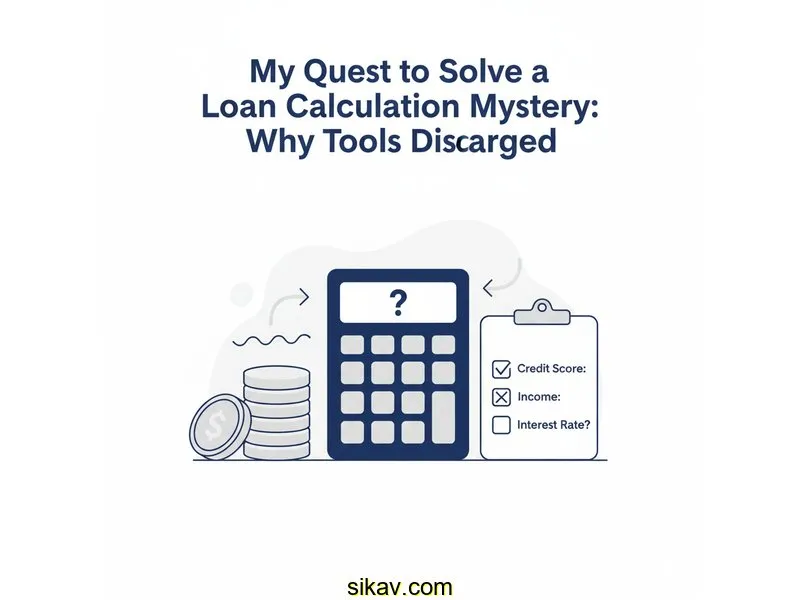
Auto Loan Calculator
Calculate payments over the life of your Loan
Home Blog Privacy Terms About Contact
Calculate payments over the life of your Loan
Home Blog Privacy Terms About ContactPublished on October 14, 2025

It all started on a quiet Tuesday evening with two browser tabs open. On one screen, a simple loan calculator. On the other, a slightly more complex one. I was trying to understand how monthly payments were calculated, purely as a mental exercise. I wasn't applying for anything; I was just curious about the math behind the numbers we see every day.
My experiment was simple: enter the exact same information into both calculators and see if they matched. I typed in a loan amount of $13,650, an interest rate of 7.8%, and a term of 60 months. I hit "Calculate" on the first tool, and it returned a monthly payment of $281.33. Easy enough. Then I did the same on the second tool. The result? $290.15.
I stared at the screen for a solid minute. A difference of nearly $9 a month. Over five years, that's over $500. How could that be? The numbers I entered were identical. It felt like asking two different people what 2+2 equals and getting "4" from one and "4.2" from the other. Something was happening behind the scenes, a piece of the calculation I was completely missing.
This wasn't just about a few dollars; it was about understanding. What hidden variable could be so powerful that it changed the outcome without even being visible? It sparked a deep curiosity in me to peel back the layers and truly understand the mechanics of these online tools. This article is the story of that journey. It's about my personal exploration into how these calculations work, not financial advice. My goal was simply to solve the mystery of the disagreeing calculators.
My initial assumption was that I must have made a mistake. I meticulously re-entered the numbers: loan amount $13,650, interest rate 7.8%, term 60 months. The results were stubbornly the same. Calculator A showed $281.33. Calculator B showed $290.15. My frustration grew. It felt like trying to solve a puzzle with a missing piece.
My first theory was rounding. Maybe one calculator was more precise than the other? I tried finding a super-basic, no-frills calculator and manually did the math using the standard payment formula I found online: P = L[r(1+r)^n] / [(1+r)^n - 1]. Plugging in my numbers (with the annual rate of 7.8% converted to a monthly rate of 0.0065), I got... $281.33. Calculator A was correct based on the pure formula.
So, what was Calculator B doing? It had to be adding something. I looked all over the page for extra inputs. There were no obvious fields for insurance, taxes, or other costs. It was just a clean, simple interface. My mind raced with possibilities. Was it using a different compounding period? Was there some obscure banking rule it was following? This was the moment I realized I didn't just want the answer; I needed to understand the process.
The core of my confusion was that I believed "interest rate" was the only factor that determined the cost of borrowing, aside from the principal and term. Calculator B was proving that assumption wrong. It was operating on a set of rules I couldn't see, and that was unsettling. I decided to stop guessing and start investigating every pixel of that webpage until I found the hidden element that was skewing the math.
After what felt like an eternity of staring at the screen, I finally found it. Tucked away under an "Advanced Options" dropdown, almost hidden in plain sight, was a small input box labeled "Origination Fee (%)" with a pre-filled value of "2". I had completely overlooked it. Calculator A was a pure payment calculator, while Calculator B was an APR calculator assuming a common fee.
My mind lit up. The second calculator wasn't just calculating a payment on $13,650. It was calculating a 2% fee ($13,650 * 0.02 = $273), adding it to the principal, and then calculating the payment on the new, higher amount of $13,923. When I plugged this new loan amount into the pure formula, the monthly payment came out to $286.96. Still not exactly $290.15, but much closer! This told me I was on the right track but still missing a final piece about how APR is presented.
The real "aha moment" was realizing that the $290.15 figure from Calculator B was the payment required to pay off the *original* $13,650, but calculated using an APR that had been inflated by the $273 fee. The tool was showing me the true cost of borrowing, fees included, expressed as a single monthly payment. It was a more "real-world" calculation. When I set that "Origination Fee" box to "0" in Calculator B, the monthly payment instantly changed to $281.33. They matched. The mystery was solved.
The key was understanding that a financed fee effectively increases the amount of money you are borrowing. You might only receive $13,650 in your bank account, but your first payment is calculated on a balance of $13,923 (principal + fee). This was a fundamental shift in my thinking.
This journey taught me what APR really means in a practical sense. It’s not just a number; it’s a standardized measure designed to show the cost of a loan once fees are factored in. The 7.8% was the interest rate, but with the 2% fee, the actual APR for that loan would be higher, around 8.64%. Calculator B was using this more comprehensive APR to generate its payment estimate, which is why it was higher.
To confirm my discovery, I ran a new scenario. I imagined a loan for $18,200 at a 6.5% interest rate over 48 months. First, I used a simple payment calculator (no fees). The result was $430.73 per month. Then, I used an APR calculator and manually added a hypothetical 3% origination fee ($546). The new financed amount became $18,746. The payment based on this higher amount? $443.65 per month. I could now confidently predict and understand why two calculators would show different results for the same initial inputs. It was all about the fees.
This whole experience was incredibly empowering. It transformed loan calculators from magical black boxes into transparent tools I could understand and use effectively. It wasn't about finding the "best" loan, but about gaining literacy in the language of finance. Here are the core calculation lessons I took away from this journey:
As I discovered, the most common reason is that they are calculating different things. One might be a simple payment calculator using only principal, rate, and term. Another might be an APR calculator that automatically includes estimated fees (like origination fees), which increases the total amount being financed and results in a higher payment estimate.
Look for clues. Check for "Advanced Options" or "More Details" links. Sometimes, the results will explicitly state an APR that is higher than the interest rate you entered—that's a dead giveaway that fees are included. If you can't find it, a good test is to compare its result to a known, basic P&I calculator. If the numbers differ, the first calculator is adding something.
In my learning journey, I found that the "Total Interest Paid" or "Total Cost of Loan" field was the most eye-opening. While the monthly payment tells you about affordability, the total cost field (which is (Monthly Payment x Term) - Principal) shows you the actual dollar amount you'll pay for the privilege of borrowing the money. When fees are included, this number tells an even more complete story.
They are accurate for the data you enter, but they are only estimates. They can't account for all possible lender-specific fees, exact closing dates, or how your specific loan will be structured. They are fantastic educational tools for understanding how variables interact, but the final, official numbers will always come from the lender's loan documents.

My journey started with a simple discrepancy between two numbers, $281.33 and $290.15. But solving that small mystery taught me an immense amount about the mechanics of loans. I learned that the details, especially the ones hidden in dropdown menus, are what truly define the calculation. It wasn't about finding a lower payment; it was about understanding why the payments were different.
This experience cemented a belief for me: understanding the math behind personal finance isn't about being a genius. It's about being curious enough to ask "why?" when the numbers don't make sense. Don't be afraid to play with calculators, to change one variable at a time, and to see how it affects the outcome. That's how we move from confusion to clarity.
This article is about understanding calculations and using tools. For financial decisions, always consult a qualified financial professional.
Disclaimer: This article documents my personal journey learning about loan calculations and how to use financial calculators. This is educational content about understanding math and using tools—not financial advice. Actual loan terms, rates, and costs vary based on individual circumstances, creditworthiness, and lender policies. Calculator results are estimates for educational purposes. Always verify calculations with your lender and consult a qualified financial advisor before making any financial decisions.
